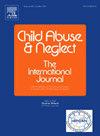Arrests among adolescents with a history of foster care placements in group home settings
IF 3.4
2区 心理学
Q1 FAMILY STUDIES
引用次数: 0
Abstract
Background
Approximately 5 % of children and adolescents in foster care are placed in group home settings, with adolescents making up the largest age group in these placements. Group home placement is designed to support individuals with high acuity or specialized needs that cannot be met in a family-based setting. Prior research has highlighted the vulnerabilities of adolescents in group homes, including behavioral issues, mental health concerns, and juvenile justice system involvement.
Objective
The current study investigated the relationship between placement status and arrest rates among adolescents experiencing a group home placement.
Participants
Child protection system records from California were used to identify adolescents (aged 13–17) who were placed in group homes in 2014 (n = 2437). These records were linked to California Department of Justice arrest records for 2014 and 2015.
Methods
Descriptive differences in arrest status were examined by demographics and placement status after initial group home placements with t-tests and logistic regression. The association between placement setting and likelihood of arrest was examined with survival analysis.
Results
In our population of adolescents who experienced a group home placement, 16.7 % were arrested during the study window. Adjusted hazard ratios for arrest were higher when adolescents lived in group homes (aHR = 1.57, p = .029) or ran away from care (aHR = 5.62, p < .001), compared to periods in which adolescents had transitioned to reunification or guardianship. During periods where adolescents were in family foster care settings, arrest rates were comparable to those who had exited to reunification or guardianship.
Conclusion
Periods when an adolescent was in a group home setting were associated with a heightened rate of arrest compared to those reunified with their families. We also found that arrests commonly occurred and reoccurred for young people residing in group homes, underscoring the need to understand whether specific protocols and practices in these facilities contribute to increased arrests.
求助全文
约1分钟内获得全文
求助全文
来源期刊

Child Abuse & Neglect
Multiple-
CiteScore
7.40
自引率
10.40%
发文量
397
期刊介绍:
Official Publication of the International Society for Prevention of Child Abuse and Neglect. Child Abuse & Neglect The International Journal, provides an international, multidisciplinary forum on all aspects of child abuse and neglect, with special emphasis on prevention and treatment; the scope extends further to all those aspects of life which either favor or hinder child development. While contributions will primarily be from the fields of psychology, psychiatry, social work, medicine, nursing, law enforcement, legislature, education, and anthropology, the Journal encourages the concerned lay individual and child-oriented advocate organizations to contribute.
 求助内容:
求助内容: 应助结果提醒方式:
应助结果提醒方式:


